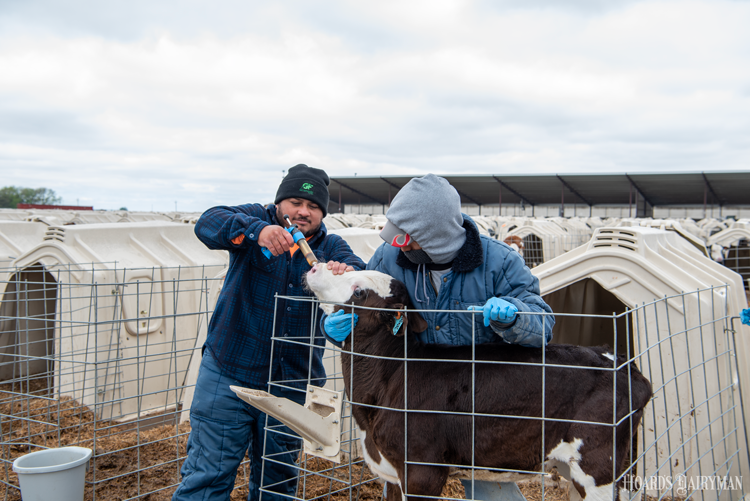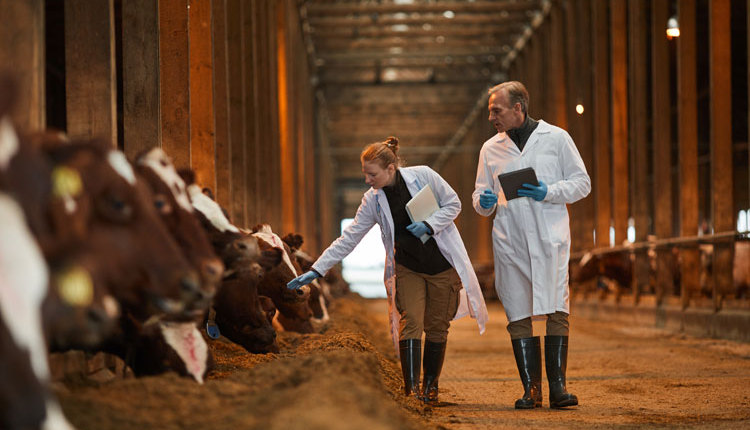
When I started in dairy practice nearly 40 years ago, vaccination strategies and schedules seemed rather straight forward. At that time, in our group veterinary practice, we were constantly sharing various client herd health issues on a weekly basis. Common problems included respiratory disease (mostly calfhood pneumonia), clostridial deaths, abortion storms, scouring calves, and reproduction issues.
During those years, in Michigan, dairy heifer replacements were also required to receive Brucella (Bangs) vaccination between 4 to 10 months of age to allow future sale as a dairy animal. This requirement was adhered to by most of our dairy farms for many years.

Calm is key
Many late afternoons and Saturdays were spent catching up on our “vaccinating and dehorning” list maintained in the practice office. We used this opportunity to also implement a basic strategy of modified live vaccines (MLV) against bovine viral diarrhea (BVD), infectious bovine rhinotracheitis (IBR), and bovine parainfluenza (PI3). Bovine respiratory syncytial virus (RSV) products had not yet appeared in the industry. Depending on the farm, we may have added a Clostridial product as well.
Injections were given, dehorning performed, and ears were tagged and tattooed. Inspection and removal of extra teats finished the task. Seasonally, if needed, pour-on products were applied to battle lice infestation. It was fun!
It didn’t take me long as a young vet to realize the huge farm-to-farm variation in size and weight of these rodeo critters. My older (more experienced) partners seemed fond of choosing the farms that had the optimal combination of enthusiastic help and decent facilities.
One of my mentors in practice in those days, Dr. Gary, was gifted with his ability to successfully throw a halter at speeding heifers circling the perimeter of the calf pen. Doc was impressive with his rodeo skills!
Clients would often share encouraging phrases when I entered the pen full of adrenaline-charged heifers. Soon my assistants learned to gather up a couple gates and some twine to help me work smarter.
I still fondly recall watching Marlin Perkins on Mutual of Omaha’s “Wild Kingdom” as a kid. As they roped, at full speed, some wild beast in Africa, Marlin would narrate, “At all costs, we try to avoid stressing these wild animals.” I quipped this phrase often in my early practice career. I appreciate that the ideal “low stress” immune response still may have been impaired!
Get the job done
We have learned much over the last 10 to 15 years as it relates to bovine immunology, with more knowledge and wisdom to come. Vaccinating is simply getting the vaccine into the animal. Immunizing requires a healthy animal, proper timing, good nutritional status, and boostering. Let’s walk through the common stages of immunizing our dairy animals, starting with neonatal calves.
Important criteria to evaluate here are the calving environment and colostrum, which is perhaps the “gold standard” for immunizing the young. Check routinely for success of passive transfer.
Also monitor what diseases are occurring. Proper diagnosis is critical. Risk factors for disease may be influenced by housing.
Have the dry cows and springers been immunized? There is no need to double up on vaccinations. For example, if a vaccination for E. coli, rotavirus, and coronavirus is being used in dry cows, there is no need for oral antigen/antibody calf products. Some farms use neonate oral viral/bacterial antibody products successfully without the need for dry period scour vaccines. Options exist to ease compliance and handling of cattle.
Many farms are finding the intranasal products beneficial, especially with respiratory pathogens. Avoid parenteral (IM/SQ) vaccines until a minimum of 3 to 4 weeks of age. Immune response requires inflammation, and inflammation requires energy. Remember, the better passive immunity from colostrum that is received, the longer duration of great health is enjoyed.
Spend resources on great nutrition, dry and deep beds, and healthy air. In addition, mentor a calf team that excels at great husbandry. Everything matters!
For transition calves from weaning to 6 months, this time period is still an area of opportunity for many farms. Just ponder all of the stressors from housing, nutrition, and grouping changes that occur.
There are plenty of efficacious vaccines on the market for this age group. Intranasals can be boostered at weaning, hopefully prior to the move to transition housing. The calf immune system is rapidly maturing at this point, so systemic vaccination is effective, but do not stack too many too close together. Above all else, do no harm!
Spend time watching these animals in their new surroundings. How is the water availability? Is the feed readily available and adequate in nutrition to provide enough energy and protein? Do they have easy access to their feed? Are they sorting feed? Is there plenty of dry space and rest? These factors trump many products in my experience. Again, deep, dry beds with plenty of fresh air keeps them growing well.
Heifers at prebreeding and breeding age are an excellent opportunity to booster the core group of viral and bacterial antigens, such as a viral five-way vaccine and vaccines against clostridia and leptospirosis.
A modified live vaccine (MLV) 5L5 booster should be given at least 60 days prebreeding to avoid IBR reproduction concerns.
Most of these animals are in housing that enables low stress handling and effective immunization, such as self locks. These tools make the job easier to get done.
Focus on your farm
Opportunities to enhance immunity for a number of diseases exists with springing heifers, dry cows, and fresh cows, but you must carefully address the prevalence of disease on your farm. There is no perfect vaccination protocol that is universal in nature.
We have effective vaccines that are beneficial in reducing salmonella issues, coliform mastitis, bacterial pneumonia, Mycoplasma, and so forth, but be cautious stacking too many vaccines too close together. The excessive “chronic” inflammation biology revealed over the last several years is quite fascinating. We must strive to develop an effective immunizing protocol while keeping aware of “excessive” consequences, especially in transition calves and cows.
Wishing you all the best as we look forward to spring. God bless our dairy farmers!





